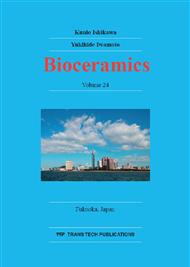p.34
p.40
p.44
p.50
p.55
p.61
p.66
p.70
p.74
Effect of Anions on Morphology Control of Brushite Particles
Abstract:
Brushite (DCPD, CaHPO4·2H2O) crystals are of great significance in a range of fields including biology, medicine, chemistry, and materials science. One important issue is the control of their morphology; when the crystal growth conditions are changed, the morphology and surface crystal conditions also change. The chemical reaction behavior depends strongly on the surface condition of the particles. Here, we report the effect of coexisting anions on the morphology control of DCPD particles. We synthesized the particles through a liquid-phase reaction by mixing a starting solution of ammonium dihydrogen phosphate (NH4H2PO4) and calcium salts. Calcium nitrate (Ca (NO3)2) and calcium acetate (Ca (CH3COO)2) were used as the calcium sources to clarify the pH dependence of the morphology. We mixed the solutions with the same pH values and agitated them, and observed the products by scanning electron microscopy (SEM) and X-ray diffraction (XRD); the DCPD morphology varies from petal-like to parallelogram structures depending on the initial pH value of the solution and the combination of the starting mixture. The effect of the acetic acid anion is to increase the driving force for the generation of DCPD crystal nuclei.
Info:
Periodical:
Pages:
55-60
Citation:
Online since:
November 2012
Authors:
Keywords:
Price:
Сopyright:
© 2013 Trans Tech Publications Ltd. All Rights Reserved
Share:
Citation:


